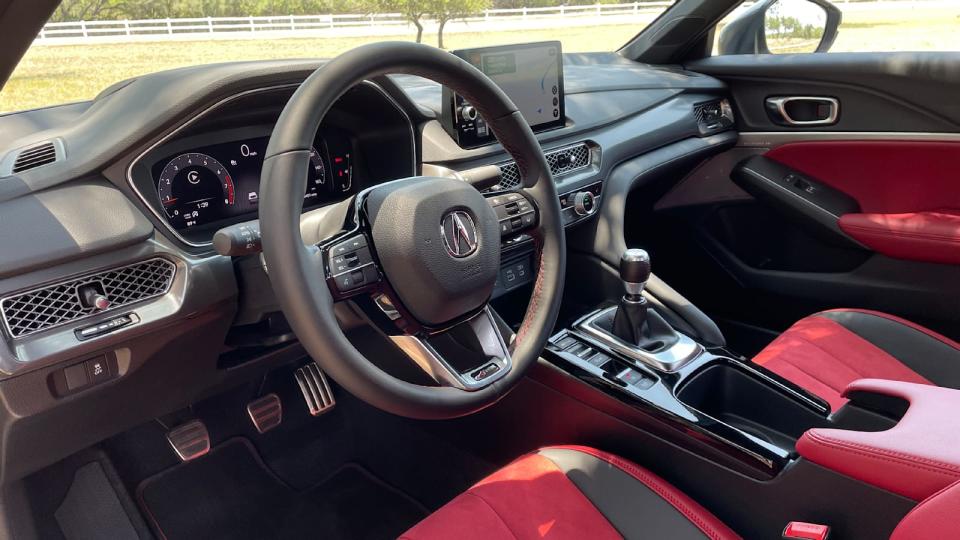2023 Acura Integra First Drive Review: Just what we wanted

AUSTIN, Texas — Getting caught up in the hype machine of retired car names pulling a Tom Brady is easy to do these days — there are so many examples to point at, and they just keep coming. The 2023 Acura Integra adds to this growing list. Expectations are high; unreasonably high if you listen to internet commenters.
An entire generation grew up, got their driver’s licenses and graduated high school in what we’ll call the Integra Drought that began when the last Acura Integra rolled off the line for the 2001 model year. And while Acura likes to think of the 2002-2006 RSX as the “fourth generation” since it was called Integra overseas, it’s meaningful that it was not called that here in the United States. You can tell how meaningful it is by observing how big of a deal Acura is treating the revival of the “Integra” name today — at this point, you’ve surely seen one of its numerous advertisements. In short, it symbolizes Acura’s serious return to a small, sporty and enthusiast-focused compact car. The outgoing ILX never captured the zeitgeist of sport compacts in the 2010s, and it faded into the background of a much larger and better small luxury car scene. It wasn’t an Integra, and Acura never pretended that it was.
To sort out what the new 2023 Integra is and isn’t, Autoblog sent me (a longtime and current 2001 Acura Integra GS-R owner) to Austin, Texas, where I was able to drive it in the city, on wide-open Texas highways and through winding switchbacks. Unlike some new Acura models that were largely developed in the U.S., the Integra was developed in Japan. The design was handled at the Wako Studio outside of Tokyo, engineering work was done in Tochigi. Meanwhile, production is exclusively taking place in Marysville, Ohio, on the same line as the TLX. Many of those involved in the development of the new Integra also worked on previous generations of the car, so you can trust that Acura/Honda developed the new one with its history being top-of-mind.




Just like Integras of the past, everything starts with the Civic. It shares a 107.7-inch wheelbase with the Civic, as both cars ride on the company’s Global Small Car Architecture. However, don’t think that the Integra is just a Civic Hatchback with an Acura badge on it. Every single body panel on the car is 100% exclusive to the Integra, and the car’s overall length and width are larger than any Civic — it’s 6.8 inches longer than the Civic Hatchback and 1.8 inches longer than the Sedan. Also on the plus side for the Integra is its stiffness. The new structure and design just happen to make the car 5% more rigid overall versus a Civic Hatchback and 2% more rigid than the Sedan.
Of course, the Civic that most will be comparing the Integra to is the Si model on account of the two sharing a powertrain: a 1.5-liter turbocharged four-cylinder that produces 200 horsepower and 192 pound-feet of torque. It has a fat torque curve, producing maximum twist from 1,800-5,000 rpm, and redline is a reasonable 6,500 rpm. The VTEC scream of yesteryear is no more, but Acura is still using VTEC for the exhaust valves, and unlike many small displacement turbo engines, this one sprints through the final 1,000 rpm with addicting eagerness. There is no loss of accelerative force at the top of the tach, which makes using the entire rev range all the more satisfying.
If this new Integra is treated anything like previous generations, the stock exhaust may not be long for the world. Nevertheless, Acura developed a unique “coil-type” exhaust for the Integra to give it a little extra growl at upper rpm. In practice, the noise is rather quiet and understated, and it won’t turn many heads below 5,000 rpm. Inside, the exhaust combines with Acura’s “Active Sound Control” system (supplemental fake noise through the speakers) to provide enough volume to keep one entertained, but it could still use more drama.

The single best feature to talk about here is the Integra’s six-speed manual transmission, which is exclusively an option on Integras with the range-topping A-Spec Technology package. In typical Honda fashion, there is simply no better manual transmission to shift at its price point. From the second my hand fell to the small, precise shift knob, my brain traveled back in time to the superb shifter of the RSX Type S. Acura updated the experience for 2022 with auto rev-matching that conveniently blips the throttle for you on downshifts. This is easily turned off through the infotainment system if you’d rather rev-match yourself. Assuming you appreciate an exceptional manual transmission shifting experience — and two-thirds of Integra pre-orders are for the manual — then you’re going to love this.
If you haven’t heard already, the controversial other shifting (or rather, lack of shifting) experience is via a continuously variable transmission. In Acura’s defense, the automatic Integra has always been a bore versus the manual, so history is at least on its side. It also provides something the manual-only Civic Si does not. On the other hand, “history” and “at least it exists” are pretty lousy excuses for offering the Civic’s CVT as an answer to the VW GTI/GLI’s dual-clutch DSG. Folks will rightfully note that the ILX actually had an eight-speed dual-clutch and wonder why the more enthusiast-oriented Integra doesn’t get such an enthusiast-oriented automatic?



 Yahoo Autos
Yahoo Autos 
